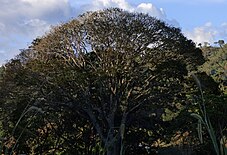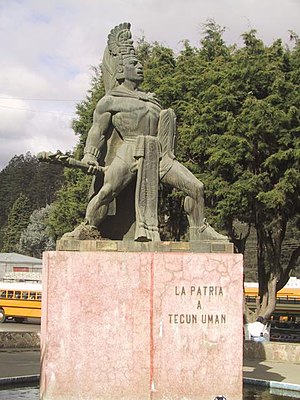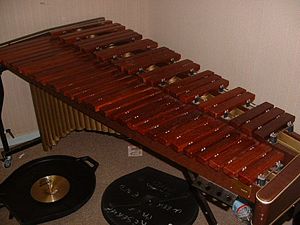National symbols of Guatemala

National symbols of Guatemala are the symbols that are used in Guatemala and abroad to represent the country and its people.
Flag of Guatemala[edit]
often referred to as "Pabellón Nacional" (literally, "National Flag") or "Azul y Blanco" ("Blue and White") features two colors: Sky blue and white. The two Sky blue stripes represent the fact that Guatemala is a land located between two oceans, the Pacific Ocean and the Atlantic Ocean (Caribbean sea); and the sky over the country (see Guatemala's national anthem). The white signifies peace and purity. The blue and white colors, like those of several other countries in the region, are based on the flag of the former Federal Republic of Central America. In the center of the flag is the Guatemalan coat of arms..[1]
Coat of Arms of Guatemala[edit]

It includes the resplendent quetzal, the national bird of Guatemala that symbolizes liberty; a parchment scroll bearing the date of Central America's independence from Spain, 15 September 1821; crossed rifles, indicating Guatemala's willingness to defend itself by force if need be; a bay laurel crown, the symbol for victory; and crossed swords, representing honor. The current coat of arms of Guatemala was adopted after the 1871 Liberal Revolution by a decree of president Miguel García Granados. It consists of multiple symbols representing liberty and sovereignty on a bleu celeste shield. According to government specifications, the coat of arms should be depicted without the shield only when on the flag, but the version lacking the shield is often used counter to these regulations[2]
National Anthem of Guatemala[edit]
The national anthem of Guatemala was written by José Joaquín Palma (1844–1911) and composed by Rafael Álvarez Ovalle It is often erroneously titled "Guatemala Feliz!" from its opening lyrics, but it has no official name and is only referred to in the country as "Himno Nacional".It was adopted in 1896 as the winning entry in a competition held by the government. The lyrics were modified slightly in 1934 by Professor Jose Maria Bonilla Ruano, a Spanish grammar scholar. Some verses were softened in their bloody context while others were enhanced in their poetic beauty[3]
National Flower of Guatemala[edit]

The Lycaste skinneri orchid, also known as the monja blanca (white nun), is the national flower of the Republic of Guatemala.[4]
In 1933, Leticia M. de Southerland, president of the International Exhibition of Flowers, celebrated in Miami Beach, Florida, sent a suggestion to the government of Guatemala that the specimen known as the Lycaste skinneri alba be designated as the national flower. This suggestion was consulted by the president of the Republic, General Jorge Ubico, with various specialists, among them was Ulises Rojas and Mariano Pacheco H. and entities like the National Library and the Society of Geography and History. The Experts took into account the beauty and the rarity of the flower and agreed with the suggestion, so that on the February 11th, 1934, the presidency of the Republic issued a decree giving the monja blanca, the denomination of national flower.
On August 9, 1946, during the governance Juan Jose Arevalo, with the purpose of protecting the species from extinction in Guatemala, a government decree was issued that prohibited the collection and export of the species. The same agreement was modified on June 4, 1947 to extend the ban on pseudobulbs and flowers, as well as to include the rest of the species of this botanical family. In 1997, when they began to make 50 cent coins, the monja blanca was used as one of the faces on the new coin[5]
National Tree of Guatemala[edit]

The Ceiba was declared the national tree of Guatemala in 1955 at the request of the botanist Ulises Rojas. This was, in part, because of its importance to the Maya. Today ceiba trees are protected by Guatemalan law.Ceiba trees can grow to more than 240 feet tall.It is the sacred tree of the Maya, as they believe the roots connect the underworld (Xibalba) with this world through the trunk and to the skies above with its leaves. The tree and the thorns are also found readily in many Mayan artifacts, including incense holders, dating before 900 AD. The tree is sometimes represented by a Mayan cross. There are many pre-Hispanic references where the ceiba tree is upholding the world[6]
National Bird of Guatemala[edit]

The resplendent quetzal is the national bird of Guatemala, and its image is found on the country's flag and coat of arms. It also lends its name to the country's currency, the Guatemalan quetzal (abbreviation GTQ)[7].Legend has it that on the day the conquistador Pedro de Alvarado fought against Tecún Umán, there was a quetzal flying overhead. On the first strike Tecún Umán, on foot, managed to disable Pedro de Alvarado's horse. Alvarado was then given another horse and on the second strike ran through Tecún Umán's chest with a spear. The quetzal flew down and landed on Tecún Umán, dipping its chest in the warrior prince's blood. It is there that the bird acquired its distinctive red chest feathers[8]
National Hero of Guatemala[edit]
Tecun Uman was declared a National Hero of Guatemala on March 22, 1960 and is celebrated annually on February 20 for the bravery and dignity he demonstrated in opposition to the Spanish Conquistadors[9]. Tecun Uman's namesakes include a small town in the department of San Marcos on the Guatemala-Mexico border as well as countless hotels, restaurants, and Spanish schools throughout Guatemala. He is also memorialized in a poem by Miguel Ángel Asturias that bears his name[10]. In contrast to his popularity, he is at times rejected by Maya cultural activists who consider his status as a national hero a source of irony, considering the long history of mistreatment of Guatemala's native population[11]

Tecun Uman (1500? – February 20, 1524) was one of the last rulers of the K'iche' Maya people, in the Highlands of what is now Guatemala. According to the Kaqchikel annals, he was slain by Spanish conquistador Pedro de Alvarado while waging battle against the Spanish and their allies on the approach to Quetzaltenango on 12 February 1524. Tecun Uman was declared Guatemala's official national hero on March 22, 1960 and is commemorated on February 20, the popular anniversary of his death. Tecun Uman has inspired a wide variety of activities ranging from the production of statues and poetry to the retelling of the legend in the form of folkloric dances to prayers. Despite this, Tecun Uman's existence is not well documented, and it has proven to be difficult to separate the man from the legend.
Legend[edit]
The legends relate that Tecun Uman entered battle adorned with precious quetzal feathers, and that his nahual (animal spirit guide), also a quetzal bird, accompanied him during the battle. In the midst of the battle, Alvarado and Tecun Uman met face to face, each with weapon in hand. Alvarado was clad in armor and mounted on his warhorse. As horses were not native to the Americas and peoples of Mesoamerica had no beasts of burden of their own, Tecun Uman assumed they were one being and killed Alvarado's horse. Another version says he merely attacked the horse in an attempt to knock Alvarado down, having no prior illusion that both man and animal to be one and the same. Tecun Uman quickly realized his error and turned for a second attack but Alvarado's thrust his spear into his opponent's heart. The K'iche' prince's nahual, filled with grief, landed on the fallen hero's chest, staining its breast feathers red with blood, and thereafter died. From that day on, all male quetzals bear a scarlet breast and their song has not been heard since. Further, if one is to be placed in captivity, it would die, making the quetzal a symbol of liberty.[1]
Another account claims a much more complex confrontation of religious and material forces[12]. In this version Tecun Uman himself literally transformed into a quetzal or, in some variations, into an eagle adorned with three crowns - one of gold, one of diamonds and one of emeralds. Other natives had attempted to kill Alvarado, but he was protected by a powerful maiden, commonly associated with the Virgin Mary. Tecun Uman called upon his own magic, and in the intention of killing Alvarado, struck Alvarado's horse dead. Upon learning he had killed only the beast and not the man, he had attempted to correct his mistake, but was quickly impaled by Alvarado's spear.[citation needed]
A different version states Tecun Uman had an opportunity to kill Alvarado but ultimately failed and was slain by one of Alvarado's subordinates, a soldier known by the name of Argueta.[13]
National Instrument of Guatemala[edit]

the marimba is part of Guatemalan culture and identity. The earliest records reveal that the marimba has been played by the Maya in Mesoamerica since 1680. It was used for ceremonial dancing, religious and social celebration, and usually played by men.[14]Feb. 20 is Día Nacional de la Marimba in Guatemala.[15]
Citations[edit]
- ↑ "Flag of Guatemala". Encyclopedia Britannica. Retrieved 2020-07-31.
- ↑ hoyhistoriagt, Autor. "Bandera de Guatemal". Hoy en la Historia de Guatemala (in español). Retrieved 2020-07-31.
- ↑ "Guatemala – nationalanthems.info". www.nationalanthems.info. Retrieved 2020-07-31.
- ↑ AGN. "Los símbolos patrios de Guatemala: cuándo se establecieron y qué representan | Agencia Guatemalteca de Noticias" (in español). Retrieved 2020-07-31.
- ↑ "Flor Nacional". 2010-06-20. Archived from the original on 2010-06-20. Retrieved 2020-07-31.
- ↑ "La Ceiba Tree of Guatemala – Revue Magazine". Retrieved 2020-07-31.
- ↑ "Banco de Guatemala". www.banguat.gob.gt. Retrieved 2020-07-31.
- ↑ Pena, Erin. "Pharomachrus mocinno (resplendent quetzal)". Animal Diversity Web. Retrieved 2020-07-31.
- ↑ "Tecún Umán Monument – Revue Magazine". Retrieved 2020-07-31.
- ↑ Poesía, Blanca Orozco de Mateos; Mateos, Blanca. "Poesía y literatura en español / Spanish poetry and literature". www.palabravirtual.com (in español). Retrieved 2020-07-31.
- ↑ "Guatemala - Everybody's Indian When the Occasion's Right". www.culturalsurvival.org. Retrieved 2020-07-31.
- ↑ "Maya Warfare". 2007-10-05. Archived from the original on 2007-10-05. Retrieved 2020-07-31.
- ↑ "Archived copy" (PDF). 2008-11-13. Archived from the original (PDF) on 2008-11-13. Retrieved 2020-07-31.CS1 maint: Archived copy as title (link)
- ↑ "The Marimba in Guatemala: The Once Muted Instrument is Heard Again". Panoramas. 2017-01-27. Retrieved 2020-07-31.
- ↑ "It's National Marimba Day In Guatemala — And For Guatemalans In The U.S." NPR.org. Retrieved 2020-07-31.
This article "National symbols of Guatemala" is from Wikipedia. The list of its authors can be seen in its historical and/or the page Edithistory:National symbols of Guatemala. Articles copied from Draft Namespace on Wikipedia could be seen on the Draft Namespace of Wikipedia and not main one.
